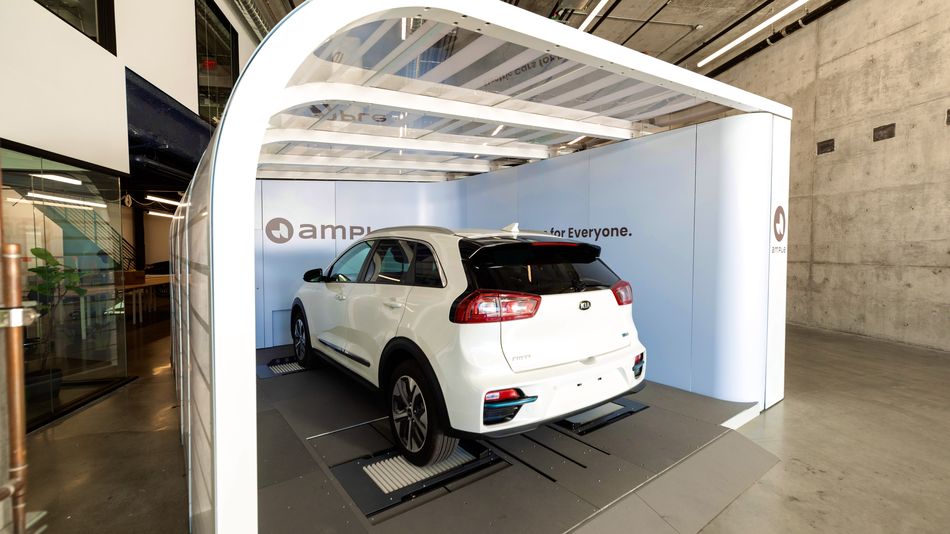Technology
How battery swapping could reduce EV charge time to just 10 minutes


The fastest electric vehicle charging stations currently get an empty battery to 80 percent full in about 30 minutes. But a new company is working on swapping out empty battery packs for fully charged ones. That would get an electric vehicle to 100 percent full in about 10 minutes.
Ample, which officially launched this week at two sites in San Francisco and another Oakland, builds and operates battery-swapping stations that use a robot to pluck out dead battery packs from under the car and replace them with packs fully charged and ready to go.
The Ample stations can be set up anywhere close to a power source so that the robot machine can get under the belly of the car and also charge a waiting supply of replacement batteries. The stations are completely autonomous and you don’t even have to get out of the car while the batteries are switched. You communicate with the station through a smartphone app.
“The beauty is it takes us a couple weeks to set up,” CEO Khaled Hassounah told me at a demo in San Francisco last week. Each station takes up two parking spaces and is temporary. If necessary, it can be moved across the street or down the block. “It fits into neighborhoods easily,” he said. There’s no drilling into the pavement or other permanent construction, like there is for the 500,000 new charging stations the federal government is supporting.
The Ample bots replace the battery units in about 10 minutes, but eventually the company anticipates speeding it up to five minutes. Pricing for the everyday EV driver is still being worked out, but it will be comparable to gasoline fill-ups. A Tesla Supercharger charging session costs about $22 for 250 miles of battery range.
Here’s the process, starting with driving into the station:
Since January, Ample has been working with Uber drivers who can rent modified Nissan Leaf plug-in cars that work with the robot system at SF locations. Eventually Ample hopes drivers will be able to buy a new EV with a modular battery back that’s compatible with the Ample swap stations. But until then, only certain drivers who are part of fleets, like Uber, will be able to use the robot stations.
Nissan is one of five automakers the company is already working with as it launches. The company wasn’t ready to share the full list quite yet, but mentioned nine different EV models (including the Leaf) that will be supported. In press photos, the Kia Niro EV was spotted parked in a station.
Battery swapping has caught on mostly in China, while in the U.S. we’re still plugging in at home and at public charging stations. Chinese EV makers have reportedly installed 452 stations throughout the country, with a large portion in Beijing. The government pledged to build more of the stations in its latest infrastructure plans. Market research group P&S Intelligence found that EVs that charge through battery swapping run 25 percent longer than those plugged in directly.
Ample’s station can be more energy efficient than a plug-in station, especially fast ones. The Ample station can charge those battery packs during low peak times, when energy is in low demand. It can also be programmed to charge the empty batteries when the grid is using more renewable energy, like wind and solar.
During the holidays and other peak times, fast charging stations have become known for long lines along major travel roads. With battery swapping, Ample is hoping to get those lines moving and cars loaded with efficiently charged energy.
-

 Business7 days ago
Business7 days agoTikTok Shop expands its secondhand luxury fashion offering to the UK
-

 Business6 days ago
Business6 days agoUnitedHealth says Change hackers stole health data on ‘substantial proportion of people in America’
-

 Business5 days ago
Business5 days agoTesla’s new growth plan is centered around mysterious cheaper models
-

 Business6 days ago
Business6 days agoMood.camera is an iOS app that feels like using a retro analog camera
-

 Business4 days ago
Business4 days agoXaira, an AI drug discovery startup, launches with a massive $1B, says it’s ‘ready’ to start developing drugs
-

 Business4 days ago
Business4 days agoUK probes Amazon and Microsoft over AI partnerships with Mistral, Anthropic, and Inflection
-

 Entertainment6 days ago
Entertainment6 days agoFurious Watcher fans are blasting it as ‘greedy’ over paid subscription service
-

 Business5 days ago
Business5 days agoTwo widow founders launch DayNew, a social platform for people dealing with grief and trauma






















